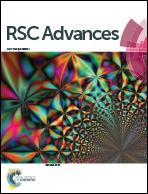Effects of immobilized VEGF on endothelial progenitor cells cultured on silicon substituted and nanocrystalline hydroxyapatites
Abstract
Vascular endothelial growth factor (VEGF) plays an essential role in angiogenesis and vascular homeostasis. Endothelial progenitor cells (EPCs) are primitive bone marrow cells participating in neovascularization and revascularization processes, which also promote bone regeneration. Synthetic hydroxyapatite (HA) has been widely used in bone repair and implant coatings. In HA-based materials, small levels of ionic substitution by silicon (Si) have significant effects on osteoclastic and osteoblastic responses. Moreover, nanocrystalline hydroxyapatites (nano-HA) display enhanced bioreactivity and beneficial effects in bone formation. In this work, the angiogenic potential of VEGF-121 adsorbed on crystalline and nanocrystalline HAs with different Si proportion is evaluated with endothelial-like cells derived from EPCs cultured on nano-HA, nano-SiHA0.25, nano-SiHA0.4, HA, SiHA0.25 and SiHA0.4 disks. The Si amount incorporated for x = 0.25 is enough to yield changes in the textural parameters and surface charge without decomposing the HA phase. Si substitution for x = 0.4 does not result in pure Si-substituted apatites. Si probably remains at the grain boundaries as amorphous silica in nano-SiHA0.4 and SiHA0.4 is decomposed in α-TCP and HA after 1150 °C treatment. Immobilized VEGF on nano-HA, nano-SiHA0.25, nano-SiHA0.4, HA, SiHA0.25 and SiHA0.4 maintains its function exerting a local regulation of the cell response. The crystallite size and topography of nanocrystalline HAs could produce insufficient and weak contacts with endothelial-like cells triggering anoikis. Concerning Si proportion, the best results are obtained with SiHA0.25/VEGF and nano-SiHA0.25/VEGF disks. All these results suggest the potential utility of SiHA0.25/VEGF and nano-SiHA0.25/VEGF for bone repair and tissue engineering by promoting angiogenesis.


 Please wait while we load your content...
Please wait while we load your content...